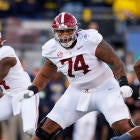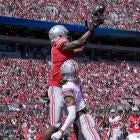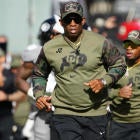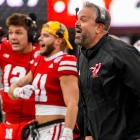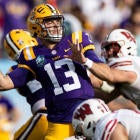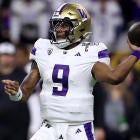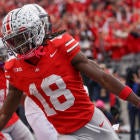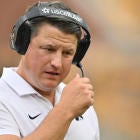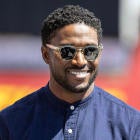The Ed O’Bannon case returns to court March 17 -- interestingly, the first day of the NCAA Tournament -- for oral arguments in the NCAA’s appeal of a federal judge's decision to allow football and men's basketball players to be compensated beyond the value of their scholarship.
In a San Francisco federal courtroom, across the San Francisco Bay from where the NCAA lost the trial in Oakland last summer, NCAA and O’Bannon lawyers will argue their points before the United States Court of Appeals for the 9th Circuit. Each side will be allotted 30 minutes -- the longest available time under the court’s guidelines -- before a three-judge panel that previously handed a former NCAA co-defendant a defeat in a similar case. Arguments have already been filed in briefs.
Some questions and answers about the NCAA’s appeal of O’Bannon:
What decision is being appealed?
The O’Bannon case, now more than five years old, deals with the commercialized use of names, images and likenesses (NILs) for FBS football and Division I men’s basketball players. Last August, US District Judge Claudia Wilken determined that the NCAA's rules "unreasonably restrain trade in the market for certain educational and athletic opportunities offered by Division I schools.”
Wilken’s injunction would allow scholarships to cover for football and men’s basketball players the full cost of attending college and permit deferred payments to players for use of their NILs for every year the athlete remains academically eligible. The NCAA has flexibility to cap the deferred payment at no less than $5,000 per year in 2014 dollars.
In its appeal, the NCAA placed the dollar amount of Wilken’s injunction at “roughly $30,000 each over four years,” or $7,500 per year. It’s based on the $5,000 NIL cap number outlined by Wilken and the gap of about $2,500 for an extra stipend to cover the full cost of attendance.
What are the NCAA’s key arguments in the appeal?
The NCAA relies heavily on the argument that Wilken erred by not applying a 1984 Supreme Court ruling that the NCAA says protects amateurism in college sports. The 1984 Oklahoma v. Board of Regents case that ended the NCAA’s monopoly on television contracts includes this passage from the Supreme Court: “in order to preserve the character and quality of the (NCAA’s) ‘product,’ athletes must not be paid, must be required to attend class and the like.”
The NCAA has successfully used this passage in court cases for decades. The O’Bannon plaintiffs say the NCAA inconsistently applies amateurism and there’s new evidence since 1984 that the commercialism of football and men’s basketball “has eroded and undermined the relationship between athletics and academics.” The plaintiffs argue that Board of Regents doesn't establish the antitrust immunity that the NCAA seeks, but rather instructed lower courts to a “Rule of Reason” analysis and that Wilken examined “an exhaustive factual record” that demonstrates not paying athletes is anticompetitive.
During the O'Bannon case, Wilken dismissed the impact of the Supreme Court language in part because “the college sports industry has changed substantially” in the 30 years since Board of Regents. The NCAA claims Wilken did not explain what precisely has changed; she’s still bound by the 1984 Supreme Court ruling; and she “yearned for what never was: commercialism and amateurism coexisted at the time of the Board of Regents just as they do today.” In fact, the NCAA says, “the amateurism rules prevent college sports from being professionalized in the face of commercial pressures.”
The NCAA is also arguing that the O’Bannon plaintiffs lack antitrust injury due to the First Amendment and Copyright Act. The NCAA says no state recognizes payments for use of NILs in telecasts of games or other non-commercial uses and the First Amendment and the Copyright Act would prevent enforcement of such right anyway.
The plaintiffs say there is no requirement to examine each state's right-of-publicity laws in relation to live game broadcasts. “In fact, a substantial majority of states recognize a broad (right of publicity), whether by statue or under the common law,” the plaintiffs wrote. “Of those states, only eight exempt sports broadcasts. The number of states not exempting sports broadcasts is all the more significant given the NCAA's observation that '[t]eam sports have been broadcast for almost a century.'"
Why did Oliver Luck make it into the O'Bannon appeal?
In theory, the O'Bannon appeal is supposed to be based on the case's past court record. That didn't stop both sides from invoking some current events to the appeal. For the O'Bannon plaintiffs, they devoted a small part of their appeal to recent comments by new NCAA executive vice president Oliver Luck in an attempt to show Wilken did not commit "judicial micromangement" with her ruling.
Since Wilken's decision, the NCAA hired Luck as one of its top executives. Luck has said college players have a "fundamental right" to be paid for use of their NILs. In her ruling, Wilken credited testimony from a plaintiffs' expert that NIL provisions in TV contracts within the NBA are “common and that they have economic value to the television networks.” The NCAA has tried to discredit that testimony and the plaintiffs countered with the words of a new top NCAA executive.
What’s the oddest new argument by the NCAA?
In disagreeing with Wilken’s ruling that would allow some payments for players, the NCAA wrote, “The court’s alternative would blur the line between amateur college sports and their professional counterparts and thereby deprive athletes of a genuine choice between the two endeavors.”
“That sentence bears re-reading,” lawyers for the Shawne Alston cost-of-attendance plaintiffs wrote in a friend-of-the-court brief. “In (the NCAA’s) view, it is the athletes that are going to be harmed because of the district court’s ruling. That contention likely does not pass the laugh-test, let alone provide a bulwark against antitrust liability.”
College athletes, of course, could “refuse the ‘minor’ payment at issue should they find it unpalatable (as unlikely as that may be),” the Alston plaintiffs wrote. Why college athletes, if given a choice, would turn down money is a head scratcher. The interest by the Alston and Martin Jenkins plaintiffs reflect other court cases in process that could be helped by favorable rulings for O'Bannon. The Jenkins plaintiffs seek a free market for players to be paid.
Who are the judges hearing the appeal?
In an unpromising development for the NCAA, the appeal will be heard by the same 9th Circuit panel that ruled against former NCAA co-defendant Electronic Arts in the similar Sam Keller case involving the former Nebraska and Arizona State quarterback. The 9th Circuit determined that O’Bannon is a “related case” to Keller so the same judges -- Sidney Thomas, Jay Bybee and Gordon Quist -- will hear O’Bannon. This doesn't guarantee an appellate victory for O'Bannon, but it's certainly not ideal for the NCAA.
In the Keller case, these judges ruled 2-1 against EA’s attempt to end a complaint that it illegally used his likeness in an NCAA video game. The panel said the game was not protected under the First Amendment as an artistic creation because “it literally recreates Keller in the very setting in which he has achieved renown.” Bybee wrote the opinion and Thomas dissented. In its appeal of O'Bannon, the NCAA wrote that Bybee and Quist ruled "erroneously" on Keller and contradicted "settled First Amendment doctrine" allowing for the expressive use of realistic images.
Even in dissent, Thomas appeared to show sympathy for college athletes. He noted that the NCAA’s 2011-12 revenue was $871.6 million, yet only 1.7 percent of senior players ever get paid professionally after putting their health at risk in college. “The issue of whether this structure is fair to the student athlete is beyond the scope of this appeal,” Thomas wrote in the Keller decision, “but forms a significant backdrop to the discussion.”
What happens if the NCAA loses the appeal?
The NCAA has said it’s preserving one aspect of its argument for a full-panel review by the 9th Circuit or the Supreme Court. An important NCAA attorney now on the case is Seth Waxman, a former US solicitor general who has argued more than 65 times before the Supreme Court. Waxman was hired in 2013 by the NCAA, which eyed the appeal process throughout the O'Bannon trial.
Whether O’Bannon would rise to the level of the Supreme Court remains to be seen. Typically, the Supreme Court takes on cases if there’s a significant issue at stake. Examples could include correcting a difference in opinion between the courts of appeals, resolving an issue that confused lower courts, or addressing a case the court believes is too significant to ignore.
The 9th Circuit, with its more liberal judges, has often been the most reversed appellate court by the Supreme Court. In the October 2013 term, the Supreme Court reviewed 12 decisions from the 9th Circuit and reversed 11 of them, according to SCOTUSblog.
When will the 9th Circuit’s opinion come?
Officially, there are no time constraints on when an opinion is issued. Unofficially, expect it sooner rather than later and well before August. The NCAA got the appeal moving in an expedited manner and the hearing is occurring even sooner than the NCAA’s request.
Why the urgency? Because even though the new benefits from the O’Bannon ruling for incoming and returning players don’t start until the 2016-17 academic year, the offers can begin on Aug. 1 of this year. If Wilken’s injunction remains in place, the NCAA will have to create a new rule that accounts for deferred payments to players.
It’s important to note: Schools wouldn’t have to offer the deferred money, but they could be at a competitive disadvantage if they don't provide extra money and a competitor does. Gender-equity issues would undoubtedly be in play if football and men's basketball players get paid and perhaps result in some female athletes being compensated as well.
Pending appeal, the clock is ticking to the day when coaches will offer some players about $5,000 extra each year to play in college.












